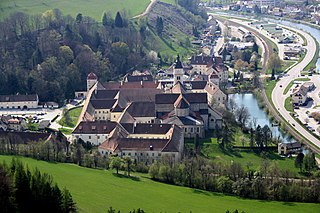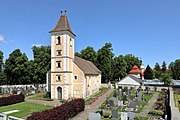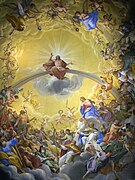
Melk Abbey is a Benedictine abbey above the town of Melk, Lower Austria, on a rocky outcrop overlooking the Danube river, adjoining the Wachau valley. The abbey contains the tomb of Saint Coloman of Stockerau and the remains of several members of the House of Babenberg, Austria's first ruling dynasty.

Göttweig Abbey is a Benedictine monastery near Krems in Lower Austria. It was founded in 1083 by Altmann, Bishop of Passau.

Seckau Abbey is a Benedictine monastery and Co-Cathedral in Seckau in Styria, Austria.

St. Lambert's Abbey is a Benedictine Abbey in the village of Sankt Lambrecht in the Styrian Grebenzen nature reserve in Austria. The monastery is located 1,072 m (3,517 ft) above sea level. The monastery complex and its gardens are part of the Zirbitzkogel-Grebenzen nature park.

Admont Abbey is a Benedictine monastery located on the Enns River in the town of Admont, Styria, Austria. The oldest remaining monastery in Styria, Admont Abbey contains the largest monastic library in the world as well as a long-established scientific collection. It is known for its Baroque architecture, art, and manuscripts.

Garsten Abbey is a former Benedictine monastery located in Garsten near Steyr in Upper Austria. Since 1851, the former monastery buildings have accommodated a prison.

Altenburg Abbey is a Benedictine monastery in Altenburg, Lower Austria. It is situated about 30 kilometres (19 mi) to the north of Krems an der Donau in the Waldviertel. It was founded in 1144,by Countess Hildeburg of Poigen-Rebgau. Throughout its history it suffered numerous invasions and attacks, and was destroyed by the Swedes in 1645. Under Emperor Joseph II in 1793 the abbey was forbidden to accept new novices, but unlike many others in Austria it succeeded in remaining functional.

Seitenstetten Abbey is a Benedictine monastery in Seitenstetten in the Mostviertel region of Lower Austria.

Saint Paul's Abbey in Lavanttal is a Benedictine monastery established in 1091 near the present-day market town of Sankt Paul im Lavanttal in the Austrian state of Carinthia. The premises centered on the Romanesque monastery church were largely rebuilt in a Baroque style in the 17th century.

Wilhering Abbey is a Cistercian monastery in Wilhering in Upper Austria, about 8 km (5 mi) from Linz. It was founded in 1146. The buildings, re-constructed in the 18th century, are known for their spectacular Rococo decoration.

Lilienfeld Abbey is a Cistercian monastery in Lilienfeld in Lower Austria, south of Sankt Pölten.

The March of Styria, originally known as Carantanian march, was a southeastern frontier march of the Holy Roman Empire. It was broken off the larger March of Carinthia, itself a march of the Duchy of Bavaria, around 970 as a buffer zone against the Hungarian invasions. Under the overlordship of the Carinthian dukes from 976 onwards, the territory evolved to be called Styria, so named for the town of Steyr, then the residence of the Otakar margraves. It became an Imperial State in its own right, when the Otakars were elevated to Dukes of Styria in 1180.

Millstatt Abbey is a former monastery in Millstatt, Austria. Established by Benedictine monks about 1070, it ranks among the most important Romanesque buildings in the state of Carinthia. The Benedictines were succeeded by the knightly Order of Saint George in 1469 and the Society of Jesus in 1598.

St. Florian Monastery is an Augustinian monastery in the town of Sankt Florian, Austria. Founded in the early ninth century, and later refounded by Augustinians in the eleventh century, St. Florian is the largest monastery in Upper Austria, and rivals Melk Abbey and Klosterneuburg Monastery as among the most impressive examples of Baroque architecture in Austria. The monastery is dedicated to Saint Florian, whose fourth century grave lies beneath the monastery.

Herzogenburg Monastery is an Augustinian monastery located in Herzogenburg in Lower Austria. Founded in 1112 by Augustinian Canons, the monastery was refurbished in the Baroque style in 1714 by Jakob Prandtauer, Johann Bernhard Fischer von Erlach, and Josef Munggenast.

Rein Abbey is a Cistercian monastery in Rein near Gratwein, Styria, in Austria. Also known as the "Cradle of Styria", it is the oldest surviving Cistercian community in the world.

Burg Festenburg is a castle in Styria, Austria. It is located in the village of Festenburg in the municipality of St. Lorenzen am Wechsel. It was founded around 1200 by the Lords of Stubenberg as Vöstenburg. It now houses the Roman Catholic parish church of St. Katharina.

Johann Jakob Zeiller was an Austrian painter.

Reichersberg Abbey is a monastery of the Innviertel Congregation of the Austrian Augustinian Canons. It lies on the Inn River in Reichersberg, Upper Austria.































